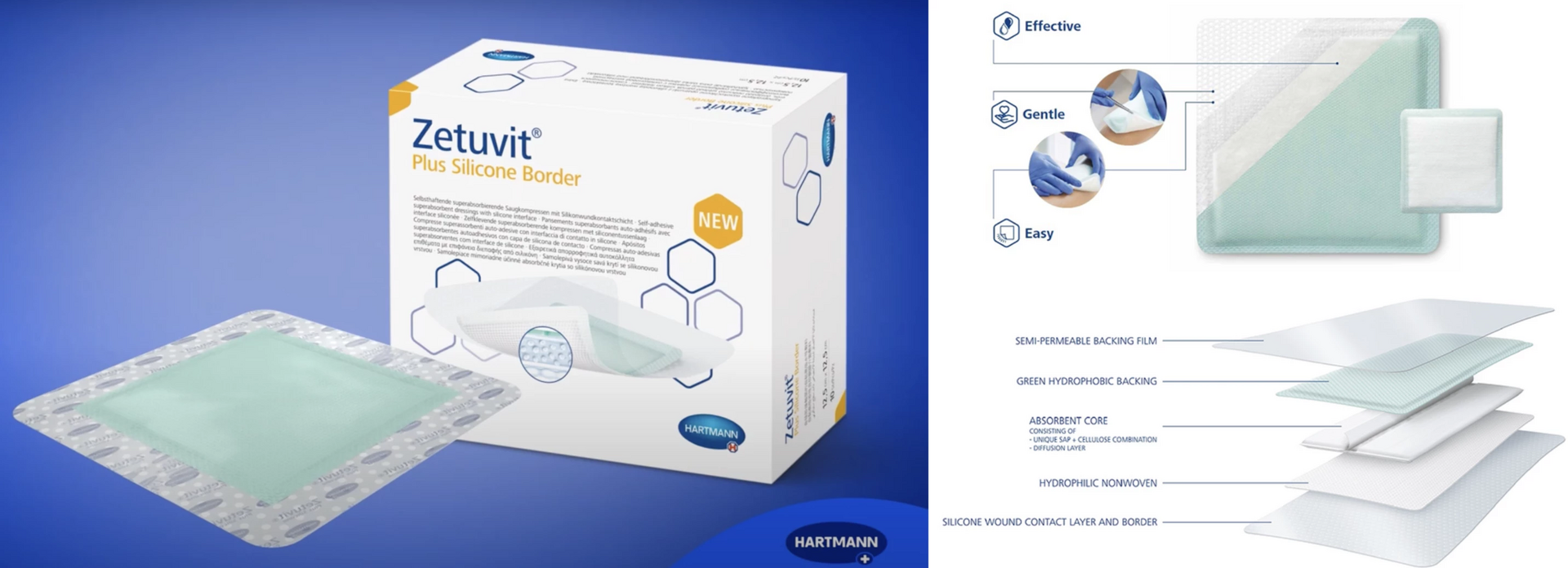Wound Healing and Exudate – A Comprehensive Look at Moisture Management in Wounds
Exudate produced during the inflammatory phase of healing is a crucial factor that ensures a moist environment in the wound, provides nutrients for cellular metabolism, and supports autolytic debridement. Without proper exudate management and maintenance of optimal moisture in the wound, patients are exposed to a range of risks and complications in healing.
COMMERCIAL INFORMATION
The Importance of Exudate
The primary role of exudate is to ensure proper moisture at the wound base, which shortens the duration and intensity of the inflammatory phase of healing. Additionally, exudate allows growth factors and immune modulators to penetrate the wound base and provides essential nutrients for cellular metabolism. Poor exudate management can lead to tissue damage and slower wound healing. Problems with exudate may pertain to its quantity or composition.
Increased exudate production has several negative impacts − patients struggle with leaking dressings, require more frequent dressing changes, and complain of pain or discomfort. Excessive exudate increases the risk of wound infection, maceration, skin erosion, and wound spreading. There is also a significant risk of protein loss and fluid/electrolyte imbalance.
How to Maintain Optimal Conditions in a Wound? The Falanga Exudate Score Helps
The fundamental prerequisite for maintaining an optimal wound environment is careful evaluation of exudate (amount, type, color, composition, and odor). It is also essential to monitor the effectiveness of the wound dressing. Thorough monitoring of all these factors enables early detection of insufficient healing, identification of risks, and appropriate intervention.
Monitoring the nature of exudate and regularly inspecting the dressing after its removal from the wound are standard steps in exudate management and overall wound care. Among various approaches to evaluating the amount of exudate, the Falanga Exudate Score dominates. This three-tier model marks the exudate level with numbers 1, 2, and 3:
- Level 1 indicates complete control over the quantity of exudate, which is minimal in the wound. Wounds in this category do not require absorbent dressings.
- Level 2, i.e., moderate amount of exudate and partial control over its quantity, usually necessitates dressing changes every 2−3 days.
- Wounds falling into the highest Level 3 produce very high amounts of exudate, and the doctor has no control over its quantity. The requirements for dressings are heightened – absorbent dressings and daily changes are necessary.
Selecting Dressings Based on Wound Moisture Levels
When choosing an appropriate dressing, the fundamental tool for moisture management, it is vital to consider the amount of exudate, the type and depth of the wound, odor, potential infection, patient needs, treatment costs, and availability. An overly dry wound requires a dressing that provides moisture or a less absorbent version of the current dressing. Reduced dressing change frequency may also be a solution. Conversely, a too-moist wound needs a dressing with better absorption capacity, secondary dressings with higher absorbency, or increased frequency of dressing changes. Negative pressure wound therapy (NPWT) or drainage may also be considered. For wounds with optimal moisture, changing the type or frequency of the dressing is unnecessary.
Caring for Wounds with Excessive Exudate
Dressings used on wounds that produce excessive exudate should have several specific properties, primarily the correct absorption capacity, which it maintains even under compression therapy. They should also absorb odor, ensure patient comfort during use and removal, contain a saturation indicator, and inactivate factors that amplify inflammation.
Dressings containing superabsorbent polymers (SAP) not only meet absorption and fluid retention requirements but also minimize the risk of maceration, capture odor, and reduce matrix metalloproteinase activity. The sterile hydropolymer dressing Zetuvit Plus Silicone Border with SAP and a silicone layer can be used as primary or secondary dressings on acute and chronic wounds with moderate to high levels of exudate. Its five-layer structure and various sizes ensure versatile use for patients with different types of exuding wounds. Excellent absorption and retention properties, which minimize the risk of exudate leakage and enable less frequent atraumatic dressing changes, contribute to improving patients' quality of life. Zetuvit Plus Silicone Border can capture various bacteria (e.g., Pseudomonas aeruginosa, Staphylococcus aureus, and Corynebacterium striatum), reducing the risk of infection and associated odor.
The combination of all these properties of this hydropolymer dressing with SAP contributes to shortening the healing time of moderately to heavily exuding wounds and reducing the costs of their treatment.
(pak)
Source: The Importance of Exudate Management in the Wound Healing Process. Medical Tribune, 25. 10. 2023.
Did you like this article? Would you like to comment on it? Write to us. We are interested in your opinion. We will not publish it, but we will gladly answer you.


